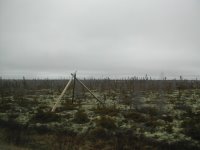 As soon as I open my eyes, I know that we are on the famous home straight, the long straight stretch of track that runs from north of Gillam (our last stop late last night) to Churchill. The track here is at it's most unstable: while the sleepers safely keep the rails evenly spaced, the variation in the thawing of the ground means that the train is lurching from side to side. Being in the upper bunk and lying lengthways along the side of the train, I'm feeling the movement a lot. It's not inducive to motion sickness, and it doesn't feel unsafe, but it can catch you unawares. I gingerly step down from the upper bunk, trying not to be thrown off the ladder when the train lurches to one side.
As soon as I open my eyes, I know that we are on the famous home straight, the long straight stretch of track that runs from north of Gillam (our last stop late last night) to Churchill. The track here is at it's most unstable: while the sleepers safely keep the rails evenly spaced, the variation in the thawing of the ground means that the train is lurching from side to side. Being in the upper bunk and lying lengthways along the side of the train, I'm feeling the movement a lot. It's not inducive to motion sickness, and it doesn't feel unsafe, but it can catch you unawares. I gingerly step down from the upper bunk, trying not to be thrown off the ladder when the train lurches to one side.My first glimpse outside confirms that we are most definitely in Manitoba's far north. This is wilderness. Nothing but rough tundra and occasional stumpy looking trees, growing as if under twice the normal pressure of gravity. The sky is a bright grey, and there are patches of snow on the ground. Some still patches of water are frozen over. While the ground supports some very green moss, the pallette of colours outside my window is much more muted than down south. It's an earthy, cold scene. Other than the bright moss, the trees and bushes are dark dark green. However, for what must be such an inhospitable place, there is a remarkable variety of plant life here.
 To our left are tall steel electricity pylons. To our right are the much older wooden tripod telegraph poles. These were probably built soon after the railway opened in the late nineteen-twenties, and they no longer support any wires. They were built in a tripod form so that they could move up and down with the freezing and thawing ground. A normal wooden telegraph pole would soon fall over as the earth moved around it's base.
To our left are tall steel electricity pylons. To our right are the much older wooden tripod telegraph poles. These were probably built soon after the railway opened in the late nineteen-twenties, and they no longer support any wires. They were built in a tripod form so that they could move up and down with the freezing and thawing ground. A normal wooden telegraph pole would soon fall over as the earth moved around it's base.
No comments:
Post a Comment